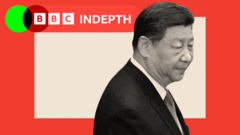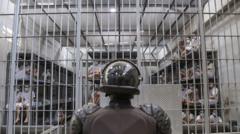China's economy, building resilience against US tariffs, grapples with a housing crisis, job insecurity, and declining consumer confidence. President Xi aims to transform these challenges into growth opportunities, while recognizing the need for robust domestic policies to ensure stability.**
Xi Jinping’s Challenge: Navigating Economic Turbulence Amidst Trump’s Tariffs**

Xi Jinping’s Challenge: Navigating Economic Turbulence Amidst Trump’s Tariffs**
As the trade war intensifies, President Xi Jinping faces mounting domestic economic pressures and youthful discontent, all while seeking new avenues for China's growth and global standing.**
China’s economic landscape is increasingly complex, marked by the looming shadow of escalating tariffs from former US President Donald Trump. Contrary to expectations, tariffs of up to 145% have not sent Chinese traders into panic; instead, they have ignited a wave of nationalistic memes and online mockery. President Xi Jinping, confident in his nation's self-reliance, faces not only the pressures of international tariffs but also entrenched domestic economic troubles.
China's dependency on exports has shifted significantly over the past decade, making it less vulnerable to trade disruption. Still, it faces core issues including a housing market collapse, job insecurity, and an aging population leading to reduced consumer spending. The severity of the housing crisis, with an oversupply of vacant homes—some estimates suggesting enough for three billion people—has left Chinese families cautious with their finances. A palpable uncertainty about jobs, pensions, and the future is further exacerbated by soaring youth unemployment, with over 20% of urban youth currently jobless.
The government's initial strategies to bolster the economy through community subsidies and spending incentives have drawn skepticism. Experts argue these measures are not sustainable without addressing the underlying economic concerns that question Xi's promise of prosperity. As the dissatisfaction grows, particularly among younger generations, underlying tensions may pose risks to political stability. Recent reports indicate a rise in protests linked to economic disappointments, although they remain under heavy censorship.
China's pivot towards advanced manufacturing and technology sectors, marked by achievements in electric vehicles and AI, indicates potential to shift challenges into opportunities. The current tariff situation, though restrictive, is seen as a catalyst for China to diversify its export markets beyond the US, tapping into stronger relationships with Southeast Asia, Africa, and Latin America. The Belt and Road Initiative further strengthens this strategy, allowing China to present itself as a stable trade partner amid US unpredictability.
Despite the turmoil, Xi aims to counteract the potential fallout from tariffs by presenting China as an attractive alternative in global trade. However, he must tread carefully, as past trade tensions have left a contentious legacy that may hinder fruitful ties with new partners. As the situation evolves, Xi’s ability to bolster domestic demand while negotiating his nation’s position in a shifting geopolitical landscape is crucial for ensuring China's stability and long-term growth in the face of adversity.
In essence, the real battleground lies within China’s own economic policies and the adaptability of its market to navigate the dual challenges posed by international tariffs and internal unrest.






















